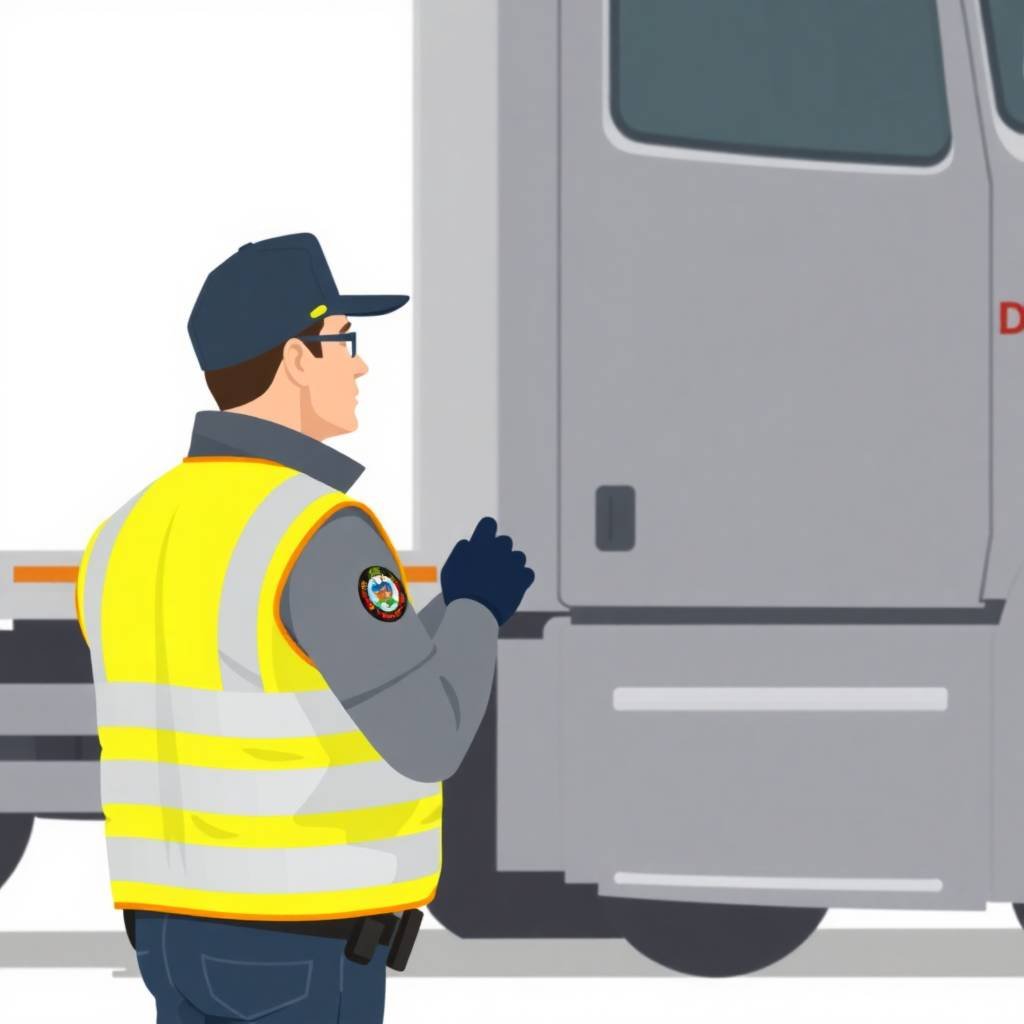1. Understanding the Scope of DOT Hazmat Compliance Overview
Transporting hazardous materials is one of the most highly regulated activities in the trucking industry. A thorough understanding of the DOT Hazmat Compliance Overview is not just a regulatory requirement but a critical aspect of safety and risk management for carriers and drivers alike. This article will walk you through what this compliance entails, its impact on operations, and how you can avoid common pitfalls.
What Is the DOT Hazmat Compliance Overview?
The DOT Hazmat Compliance Overview encompasses the rules and responsibilities outlined by the U.S. Department of Transportation (DOT) and enforced by the Federal Motor Carrier Safety Administration (FMCSA). These regulations aim to ensure the safe and secure transport of hazardous materials across public roadways. For a full list of current regulations, refer to the FMCSA website and Transportation.gov.
At its core, the DOT Hazmat Compliance Overview requires carriers to maintain specific safety protocols, employee training programs, accurate documentation, and periodic inspections. It is also critical to stay updated with FMCSA regulatory changes through reliable sources like Truckers Compliance Hub.
Key Components of Hazmat Compliance
A successful hazmat program incorporates training, documentation, reporting, and incident prevention. Essential areas include:
- Pre-employment DOT drug testing requirements
- Driver drug and alcohol testing program
- Driver qualification file requirements
- DOT compliance checklist
All these factors are addressed under the DOT Hazmat Compliance Overview to reduce risks during hazmat transportation.
Common Compliance Pitfalls
Many carriers fail compliance audits due to overlooked documentation or incomplete training records. Issues such as DQ file violations and mismanaged drug testing policies can lead to costly penalties. The FMCSA Clearinghouse Compliance is also a crucial component in avoiding these missteps.
To avoid these costly mistakes, consider working with experts. You can schedule your compliance consultation today.
Services to Support Your Compliance
Truckers Compliance Hub provides a full suite of support services to help you comply with the DOT Hazmat Compliance Overview, including:
- DOT audit preparation
- Drug and alcohol testing management
- IFTA, IRP, and BOC-3 support
- Driver safety score management
- How to correct FMCSA violations
For owner-operators, explore our specialized solutions:
Staying Ahead of Regulatory Changes
As rules evolve, staying informed is essential. Learn more about new trends like the FMCSA Safety Measurement System SMS 2025 and strategies for new entrant safety audit survival.
You can also find insights on avoiding FMCSA compliance mistakes and meeting FMCSA compliance requirements.
Navigating the DOT Hazmat Compliance Overview can be complex, but with the right resources and expert support, your fleet can operate safely and efficiently. To access ongoing support, visit Truckers Compliance Hub, explore our compliance help for trucking companies, and review our Disclaimer and Terms of Service.
Staying compliant means protecting your business, your drivers, and the communities you serve. Take the proactive route with a full understanding of the DOT Hazmat Compliance Overview.

2. Step 1: Properly Classify Your Hazardous Materials
Step 1: Properly Classify Your Hazardous Materials
In the realm of hazardous materials transportation, the DOT Hazmat Compliance Overview begins with a critical first step: proper classification. Accurate classification is not only a regulatory requirement but also a fundamental aspect of ensuring safety, compliance, and efficiency in the transportation process.
Understanding Hazardous Material Classification
The U.S. Department of Transportation (DOT) classifies hazardous materials into nine distinct classes, each representing a specific type of hazard:(U.S. Compliance)
- Explosives
- Gases
- Flammable Liquids
- Flammable Solids
- Oxidizers and Organic Peroxides
- Toxic and Infectious Substances
- Radioactive Materials
- Corrosives
- Miscellaneous Dangerous Goods(freightquote.com, U.S. Compliance)
Each class has specific criteria and requirements for packaging, labeling, and documentation. For detailed information on these classes, refer to the DOT’s Hazardous Materials Regulations.(FMCSA)
The Importance of Accurate Classification
Proper classification is essential for several reasons:
- Safety: Ensures that hazardous materials are handled and transported safely, minimizing risks to people and the environment.
- Compliance: Meets regulatory requirements, avoiding fines and legal issues.
- Efficiency: Facilitates proper packaging, labeling, and documentation, streamlining the transportation process.
Misclassification can lead to serious consequences, including accidents, environmental damage, and significant financial penalties.
Steps to Proper Classification
- Identify the Material: Obtain the Safety Data Sheet (SDS) for the material, which provides essential information on its properties and hazards.(Departamento de Transporte)
- Determine the Hazard Class: Using the SDS and the DOT’s classification criteria, determine the appropriate hazard class for the material.(U.S. Compliance)
- Assign the Proper Shipping Name and UN Number: Refer to the Hazardous Materials Table to find the correct shipping name and UN identification number.(phmsa.dot.gov)
- Select Appropriate Packaging: Choose packaging that meets the requirements for the specific hazard class and ensures the safe containment of the material.
- Label and Mark the Package: Apply the correct labels and markings as specified by the DOT regulations.(Departamento de Transporte)
- Prepare Shipping Documentation: Complete all necessary documentation, including the shipping papers, emergency response information, and certifications.(freightquote.com)
- Train Employees: Ensure that all employees involved in the transportation process are properly trained in hazardous materials handling and compliance.
For a comprehensive guide on these steps, visit the Check the Box: Getting Started with Shipping Hazmat page.(Departamento de Transporte)
Resources for Compliance
Maintaining compliance with hazardous materials regulations requires ongoing effort and access to reliable resources. The Federal Motor Carrier Safety Administration (FMCSA) provides extensive information on regulations, safety guidelines, and compliance assistance.
Additionally, Truckers Compliance Hub offers a wealth of resources and services to support carriers in achieving and maintaining compliance, including:
- DOT Audit Preparation
- DOT Compliance Checklist for Owner-Operators
- Driver Safety Score Management
- Drug and Alcohol Testing Management
- How to Correct FMCSA Violations
- UCR Filing Deadlines
- IFTA IRP BOC-3 Support
- CSA Intervention Thresholds
- New Entrant Safety Audit Survival Tips
For personalized assistance, schedule an appointment with our compliance experts through this link.
Conclusion
Proper classification of hazardous materials is the foundational step in the DOT Hazmat Compliance Overview. It ensures safety, regulatory compliance, and efficient transportation operations. By understanding and implementing the correct classification procedures, carriers can avoid costly mistakes and contribute to a safer transportation environment.
For more information and resources on hazardous materials compliance, visit the U.S. Department of Transportation and Truckers Compliance Hub.
Please review our Disclaimer and Terms of Service for more information.

3. Step 2: Accurate Packaging and Labeling — No Room for Error
In the realm of hazardous materials transportation, precision in packaging and labeling is paramount. The “DOT Hazmat Compliance Overview” underscores the critical nature of these elements, as even minor oversights can lead to significant safety hazards and regulatory penalties.
Understanding Packaging Requirements(Wikipedia)
The U.S. Department of Transportation (DOT) mandates that hazardous materials be packaged in a manner that ensures safety during transit. According to the Federal Motor Carrier Safety Administration (FMCSA), packaging must be compatible with the material’s properties and capable of withstanding transportation stresses. This includes using United Nations (UN) performance-oriented packaging standards, which are designed to prevent leaks, spills, and contamination.(U.S. Compliance)
For a comprehensive understanding of packaging standards, refer to the Hazardous Materials Regulations provided by the DOT.
Labeling: A Critical Component
Proper labeling is not just a regulatory requirement; it’s a vital communication tool that informs handlers and emergency responders about the nature of the hazardous material. Labels must be durable, clearly visible, and placed on a contrasting background to ensure readability. They should include the appropriate hazard class or division number, and when necessary, subsidiary risk labels.(Wikipedia, PHMSA)
The Hazardous Materials Markings, Labeling, and Placarding Guide offers detailed information on labeling requirements.(PHMSA)
Common Pitfalls and How to Avoid Them
Non-compliance with packaging and labeling regulations can result in severe consequences, including fines and shipment delays. Common mistakes include using incorrect packaging materials, improper labeling, and failing to update labels when the contents change.
To mitigate these risks, it’s advisable to conduct regular audits and training. Resources like the DOT Compliance Checklist and DOT Audit Preparation services can be instrumental in maintaining compliance.
Leveraging Expert Resources
Navigating the complexities of hazardous materials transportation requires expertise. Platforms like Truckers Compliance Hub offer a wealth of information, including articles on FMCSA Clearinghouse Compliance, Drug and Alcohol Testing Compliance, and Driver Qualification File Requirements.(Wikipedia)
For personalized assistance, consider scheduling an appointment through this link.
Staying Informed and Compliant
Compliance is an ongoing process that requires staying updated with the latest regulations and best practices. Regularly reviewing resources like the FMCSA Safety Measurement System SMS 2025 and understanding CSA Intervention Thresholds can help in maintaining a strong compliance posture.
For more information on compliance services tailored for trucking companies and owner-operators, explore the following resources:
Please note that the information provided here is for general guidance. For more details, refer to our Disclaimer and Terms of Service.

4. Step 3: Master the Hazardous Materials Shipping Paper Requirements
Accurate documentation is one of the cornerstones of hazardous materials (hazmat) transportation compliance. Within the DOT Hazmat Compliance Overview, shipping papers represent a critical step that cannot be overlooked. Mastering the hazardous materials shipping paper requirements ensures legal compliance, facilitates safe transport, and provides essential information to emergency responders.
Understanding the Role of Shipping Papers
In the context of the DOT Hazmat Compliance Overview, shipping papers serve as the official record of hazmat being transported. These documents must clearly identify the hazardous material, include proper shipping descriptions, and be readily accessible during transportation. Errors or omissions on shipping papers are among the most common violations recorded during DOT audits.
Proper shipping descriptions include the identification number, proper shipping name, hazard class, and packing group. The shipping paper must also contain emergency contact information and certification by the shipper that the shipment complies with applicable regulations.
The Department of Transportation outlines these requirements in detail, and they are enforced through FMCSA inspections. Trucking companies must understand and implement these standards as part of their broader FMCSA compliance requirements.
Why Shipping Paper Accuracy Matters
A thorough DOT Hazmat Compliance Overview emphasizes the importance of accuracy. Inaccurate or incomplete shipping papers can lead to severe consequences—including fines, shipment delays, and increased CSA scores. If a carrier is found with incorrect documentation during an audit, it may also trigger deeper investigations or require costly corrective actions.
To avoid common FMCSA compliance mistakes, carriers must train drivers and shipping personnel to complete documentation correctly. Utilizing resources such as the DOT Compliance Checklist or services for driver qualification file requirements can provide ongoing support.
Best Practices for Managing Hazmat Shipping Papers
A successful DOT Hazmat Compliance Overview strategy includes detailed recordkeeping, timely updates, and standardized processes. Carriers can benefit from implementing tools for driver safety score management and support with drug and alcohol testing management, both of which tie into broader compliance strategies.
To gain clarity and ensure your team is aligned with hazmat shipping requirements, consider scheduling a consultation with compliance professionals who specialize in DOT and FMCSA regulations.
Leverage Expert Guidance and Stay Compliant
As hazmat regulations evolve, staying current is essential. Trucking professionals can regularly check the Truckers Compliance Hub for updates and resources, including insights on the FMCSA Clearinghouse, random DOT drug testing requirements, and DQ file violations.
Additionally, support services like CSA intervention thresholds, UCR filing deadlines, and IFTA IRP BOC-3 support can help mitigate risk and enhance operational compliance.
Additional Resources and Legal Notes
For carriers seeking customized help, we offer FMCSA compliance services for trucking companies and owner-operators. If you’re navigating a new entrant audit, our safety audit survival tips can prepare you.
Please refer to our Disclaimer and Terms of Service for full details on the use of our resources. Accurate shipping documentation is step three in your journey toward a complete DOT Hazmat Compliance Overview—mastering it is not optional, it’s essential.

5. Step 4: Required Training for Hazmat Employees and Drivers
When it comes to the DOT Hazmat Compliance Overview, training is not just a recommendation—it’s a federal requirement. Ensuring that all hazmat employees and drivers are properly trained is critical for safety, legal compliance, and operational efficiency. Failure to meet these training standards can lead to costly FMCSA compliance mistakes and significant enforcement actions.
The Legal Mandate Behind Hazmat Training
According to the U.S. Department of Transportation and FMCSA, all hazmat employees must be trained within 90 days of employment and receive recurrent training every three years. This is a core component of the DOT Hazmat Compliance Overview. Training must include general awareness, function-specific duties, safety procedures, and security awareness.
For drivers, this training supplements other key requirements, such as drug and alcohol testing compliance, driver qualification file requirements, and DQ file violations. Hazmat training ensures they know how to identify hazardous materials, properly complete documentation, handle emergencies, and follow critical safety practices.
Key Training Areas in the DOT Hazmat Compliance Overview
The DOT Hazmat Compliance Overview specifies that training must cover the following:
- General Awareness: Familiarity with hazmat regulations and recognizing hazardous materials.
- Function-Specific Training: Tailored to the employee’s role (e.g., packaging, handling, transporting).
- Safety Training: Including emergency response, accident prevention, and personal protection.
- Security Awareness: Understanding potential threats and how to respond appropriately.
Each of these areas contributes to improving a carrier’s overall safety rating within the FMCSA Safety Measurement System (SMS). Companies that invest in compliance often see benefits such as fewer violations, lower insurance costs, and improved CSA scores.
How to Stay Compliant and Train Effectively
If your team is unsure where to start with training or needs a refresher, Truckers Compliance Hub offers comprehensive tools, such as the DOT Compliance Checklist and DOT compliance checklist for owner-operators. These resources simplify the compliance process and help identify gaps in your training program.
Moreover, our services, including driver safety score management, drug and alcohol testing management, and new entrant safety audit survival tips, are designed to support every aspect of your DOT Hazmat Compliance Overview journey.
To receive tailored guidance or schedule a compliance review, you can book an appointment here.
Ongoing Support for Hazmat Compliance
DOT hazmat training is not a one-time requirement. To maintain full compliance, carriers must track training deadlines, maintain up-to-date documentation, and ensure all new hires are properly onboarded. Additional support is available for how to correct FMCSA violations, CSA intervention thresholds, and UCR filing deadlines.
For companies looking to streamline their training and compliance processes, our team offers solutions for FMCSA compliance help and owner-operator services.
Explore our Terms of Service and Disclaimer to understand how we protect your data and ensure accurate compliance guidance.
Training is a non-negotiable step in the DOT Hazmat Compliance Overview. Prioritize it, formalize it, and your business will be prepared for inspections, audits, and safe operations.

6. Step 5: Vehicle Placarding – Visibility Is Vital
One of the most visible components of the DOT Hazmat Compliance Overview is vehicle placarding. Placards are not just colorful stickers—they are critical safety tools that identify hazardous materials during transportation. Failing to display proper placards is a serious violation that can compromise public safety and result in substantial penalties from the FMCSA and U.S. Department of Transportation.
Why Placarding Matters in DOT Hazmat Compliance
Placards inform first responders, inspectors, and the public of the dangers present in a vehicle. Whether it’s flammable liquids, corrosive substances, or toxic materials, placards are a universal language for hazard communication. In the DOT Hazmat Compliance Overview, this step is vital for both accident prevention and efficient emergency response.
Improper or missing placards can negatively impact your Safety Measurement System (SMS) score, trigger audits, and highlight FMCSA compliance mistakes. Understanding and implementing placarding requirements ensures your fleet operates within the framework of the DOT compliance checklist and supports better CSA scores.
DOT Hazmat Compliance Overview: Placard Requirements
Per the DOT Hazmat Compliance Overview, placards must be:
- Displayed on all four sides of the vehicle
- Visible from a distance
- Resistant to weather, fading, and damage
- Applicable to the hazardous materials being transported
Failure to comply could result in violations identified during DOT audits or new entrant safety audits.
Our DOT audit preparation services help ensure that carriers understand and implement these placard requirements correctly.
Placarding and the Bigger Compliance Picture
Placarding is just one part of the broader DOT Hazmat Compliance Overview. A compliant operation must also manage driver qualification files, drug and alcohol testing programs, and DQ file violations.
For a comprehensive view of your compliance health, explore our DOT compliance checklist for owner-operators, driver safety score management, and drug and alcohol testing management services.
You can also access guidance on how to correct FMCSA violations, CSA intervention thresholds, UCR filing deadlines, and IFTA, IRP, and BOC-3 support.
Schedule Support to Stay Placard-Compliant
If you’re unsure whether your vehicles meet the placarding standards required in the DOT Hazmat Compliance Overview, schedule a consultation with our compliance specialists today. We’ll help assess your operations and close any compliance gaps.
You can also explore our previous articles on pre-employment DOT drug testing, random DOT drug testing, and FMCSA Clearinghouse compliance for a full-circle approach to fleet safety and legal readiness.
Compliance Resources You Can Trust
At Truckers Compliance Hub, we provide detailed resources and services tailored to both fleet managers and owner-operators. Check out our guides on FMCSA compliance services for owner-operators and FMCSA compliance help for trucking companies to get started.
As always, our services are governed by our Terms of Service and Disclaimer, ensuring transparency and professionalism in every engagement.
Placarding isn’t optional—it’s a legal necessity. Make visibility your priority and strengthen your overall DOT Hazmat Compliance Overview today.

7. Step 6 & 7: Emergency Response and Recordkeeping – Two Keys to Long-Term Compliance
When it comes to hazardous materials transportation, emergency preparedness and meticulous documentation are the backbone of any compliant operation. In the DOT Hazmat Compliance Overview, Steps 6 and 7—Emergency Response and Recordkeeping—are essential for safety, liability management, and long-term regulatory compliance.
Emergency Response: Be Prepared, Not Surprised
An effective emergency response plan is non-negotiable in the DOT Hazmat Compliance Overview. Drivers and hazmat employees must be trained to handle incidents involving spills, leaks, fires, or exposure to hazardous substances. This includes knowledge of Material Safety Data Sheets (MSDS), use of protective gear, and communication protocols with local authorities.
The U.S. Department of Transportation mandates that emergency response information must accompany every shipment and be readily accessible in case of an incident. Additionally, the FMCSA requires carriers to have robust procedures for contacting first responders and mitigating risks on the scene.
If your company is unsure how to build or assess an emergency response plan, our DOT audit preparation services can help close critical compliance gaps.
Recordkeeping: The Paper Trail That Protects You
Step 7 in the DOT Hazmat Compliance Overview focuses on maintaining accurate, up-to-date records. This includes shipping papers, training certifications, emergency response documentation, and hazmat incident reports. Recordkeeping is not just a requirement; it’s your first line of defense in the event of an audit or legal inquiry.
Failure to maintain proper documentation can lead to violations during FMCSA compliance reviews or new entrant safety audits. Keeping your driver qualification files and drug and alcohol testing records up to date is essential.
For streamlined compliance management, explore our DOT compliance checklist for owner-operators and driver safety score management services.
Integrating Emergency Planning and Recordkeeping into Overall Compliance
The DOT Hazmat Compliance Overview emphasizes that emergency response and recordkeeping are interconnected. For instance, each training session related to emergency procedures must be documented, as must any updates to your drug and alcohol testing management program.
Many carriers overlook these details, leading to common FMCSA compliance mistakes. At Truckers Compliance Hub, we guide carriers through complex requirements, from pre-employment drug testing to random DOT drug testing and FMCSA Clearinghouse compliance.
We also help companies correct FMCSA violations, navigate CSA intervention thresholds, and meet UCR filing deadlines. Whether you need assistance with IFTA, IRP, or BOC-3 documentation, we provide comprehensive support tailored to your needs.
Secure Your Compliance Now
If you’re unsure whether your emergency protocols or recordkeeping processes meet the expectations of the DOT Hazmat Compliance Overview, it’s time to act. Schedule an appointment with our experts for a custom consultation.
For additional resources, visit our latest posts at Truckers Compliance Hub and explore our specialized compliance services for both trucking companies and owner-operators.
All information is provided under our Disclaimer and Terms of Service. Don’t leave compliance to chance—master Steps 6 and 7 of the DOT Hazmat Compliance Overview for a safer, more reliable fleet.

What is the DOT Hazmat Compliance Overview, and why is it important for motor carriers?

The DOT Hazmat Compliance Overview refers to the federal regulations that govern the transportation of hazardous materials by motor carriers. It’s critical because non-compliance can lead to hefty fines, revoked operating authority, and serious safety hazards. Ensuring you’re prepared for a DOT audit is essential. Our DOT audit preparation services can help you stay compliant and avoid these costly consequences.
What types of training are required under the DOT Hazmat Compliance Overview?

Under the DOT Hazmat Compliance Overview, all hazmat employees must receive general awareness, safety, and function-specific training every three years. Failing to document this properly can result in violations. To stay on track with compliance, our drug and alcohol testing management services can support your broader training and monitoring requirements.
How does vehicle documentation tie into the DOT Hazmat Compliance Overview?

Accurate and accessible shipping papers and records are essential components of the DOT Hazmat Compliance Overview. This includes proper maintenance of driver qualification (DQ) files. Our DQ file setup and monitoring solutions ensure your documentation is always audit-ready, helping you meet DOT expectations and avoid unnecessary penalties.
What role does registration and permitting play in DOT Hazmat compliance?

One overlooked aspect of the DOT Hazmat Compliance Overview is maintaining current state and federal registrations, such as IFTA, IRP, and BOC-3 filings. These credentials ensure your company operates legally across state lines. We offer IFTA, IRP, and BOC-3 support to help you manage these filings efficiently and stay compliant.
How can UCR filing affect my DOT Hazmat Compliance status?

Although not directly tied to hazmat regulations, UCR compliance supports your overall regulatory standing and is often reviewed during inspections. Staying current with UCR requirements helps maintain a clean record under the DOT Hazmat Compliance Overview. If you need help, our UCR filing assistance service can take the guesswork out of compliance.
Igor Iturriaga is a transportation compliance expert and founder of Dynamic 305 Miami LLC. He helps owner-operators and fleets stay FMCSA-compliant and audit-ready. https://www.linkedin.com/in/igor-iturriaga-64503217/
